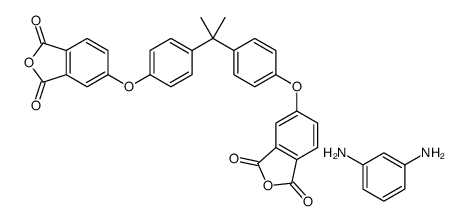61128-46-9
| 中文名 | 聚醚酰亚胺 |
|---|---|
| 英文名 | benzene-1,3-diamine,5-[4-[2-[4-[(1,3-dioxo-2-benzofuran-5-yl)oxy]phenyl]propan-2-yl]phenoxy]-2-benzofuran-1,3-dione |
| 中文别名 | 5,5-[(1-甲基亚乙基)双(4,1-亚苯氧基)]双-1,3-异苯并呋喃二酮与1,3-亚苯二胺的聚合物 |
| 英文别名 |
5-[4-[2-[4-[(1,3-dioxo-2-benzofuran-5-yl)oxy]phenyl]propan-2-yl]phenoxy]-2-benzofuran-1,3-dione
1,3-Isobenzofurandione,5,5'-((1-methylethylidene)bis(4,1-phenyleneoxy))bis-,polymer with 1,3-benzenediamine PEI MFCD00217701 |
| 密度 | 1.27 g/mL at 25ºC(lit.) |
|---|---|
| 沸点 | 712.3ºC at 760 mmHg |
| 分子式 | C37H28N2O8 |
| 分子量 | 628.62700 |
| 闪点 | 302.2ºC |
| 精确质量 | 628.18500 |
| PSA | 157.24000 |
| LogP | 8.23170 |
| 储存条件 | 保持贮藏器密封 放入紧密的贮藏器内,储存在阴凉,干燥的地方 |
| 稳定性 | 遵照规定使用和储存则不会分解。 |
| 计算化学 | 1.疏水参数计算参考值(XlogP):无 2.氢键供体数量:2 3.氢键受体数量:10 4.可旋转化学键数量:6 5.互变异构体数量:无 6.拓扑分子极性表面积157 7.重原子数量:47 8.表面电荷:0 9.复杂度:962 10.同位素原子数量:0 11.确定原子立构中心数量:0 12.不确定原子立构中心数量:0 13.确定化学键立构中心数量:0 14.不确定化学键立构中心数量:0 15.共价键单元数量:2 |
| 更多 | 1. 性状:金色丸状 2. 密度(g/mL,25/4℃):1.27 3. 相对蒸汽密度(g/mL,空气=1):无可用 4. 熔点(ºC):无可用 5. 沸点(ºC,常压):无可用 6. 沸点(ºC,5.2kPa):无可用 7. 折射率:无可用 8. 闪点(ºC):无可用 9. 比旋光度(º):无可用 10. 自燃点或引燃温度(ºC):无可用 11. 蒸气压(kPa,25ºC):无可用 12. 饱和蒸气压(kPa,60ºC):无可用 13. 燃烧热(KJ/mol):无可用 14. 临界温度(ºC):无可用 15. 临界压力(KPa):无可用 16. 油水(辛醇/水)分配系数的对数值:无可用 17. 爆炸上限(%,V/V):无可用 18. 爆炸下限(%,V/V):无可用 19. 溶解性:无可用 |
|
Section1. IDENTIFICATION OF THE SUBSTANCE/MIXTURE Product name: Polyetherimide Section2. HAZARDS IDENTIFICATION Classification of the substance or mixture Not a dangerous substance according to GHS. This substance is not classified as dangerous according to Directive 67/548/EEC.
Label elements
The product does not need to be labelled in accordance with EC directives or respective national laws. Other hazards - none Section3. COMPOSITION/INFORMATION ON INGREDIENTS Synonyms: Poly(bisphenol A-co-4-nitrophthalic anhydride-co-1,3-phenylenediamine) Polyetherimide Poly(ether imide) PEI Poly(bisphenol A anhydride-co-1,3-phenylenediamine) Poly-[2,2′bis(4-(3,4-dicarboxyphenoxy)phenylpropane)-1,3-phenylene bisimide] Poly(bisphenol A dianhydride-co-1,3-phenylenediamine) CAS-No.EC-No.Index-No.ClassificationConcentration Polyetherimide 61128-46-9---- Section4. FIRST AID MEASURES If inhaled If breathed in, move person into fresh air. If not breathing, give artificial respiration. In case of skin contact Wash off with soap and plenty of water. In case of eye contact Flush eyes with water as a precaution. If swallowed Never give anything by mouth to an unconscious person. Rinse mouth with water. Section5. FIRE-FIGHTING MEASURES Suitable extinguishing media Use water spray, alcohol-resistant foam, dry chemical or carbon dioxide. Special protective equipment for fire-fighters Wear self contained breathing apparatus for fire fighting if necessary. Section6. ACCIDENTAL RELEASE MEASURES Personal precautions Avoid dust formation. Avoid breathing vapors, mist or gas. Environmental precautions Do not let product enter drains. Methods and materials for containment and cleaning up Sweep up and shovel. Keep in suitable, closed containers for disposal. Section7. HANDLING AND STORAGE Precautions for safe handling Provide appropriate exhaust ventilation at places where dust is formed. Normal measures for preventive fire protection. Conditions for safe storage Keep container tightly closed in a dry and well-ventilated place. Store in cool place. Section8. EXPOSURE CONTROLS/PERSONAL PROTECTION Personal protective equipment Respiratory protection Respiratory protection is not required. Where protection from nuisance levels of dusts are desired, use type N95 (US) or type P1 (EN 143) dust masks. Use respirators and components tested and approved under appropriate government standards such as NIOSH (US) or CEN (EU). Hand protection Handle with gloves. Gloves must be inspected prior to use. Use proper glove removal technique (without touching glove's outer surface) to avoid skin contact with this product. Dispose of contaminated gloves after use in accordance with applicable laws and good laboratory practices. Wash and dry hands. The selected protective gloves have to satisfy the specifications of EU Directive 89/686/EEC and the standard EN 374 derived from it. Eye protection Use equipment for eye protection tested and approved under appropriate government standards such as NIOSH (US) or EN 166(EU). Skin and body protection Choose body protection in relation to its type, to the concentration and amount of dangerous substances, and to the specific work-place., The type of protective equipment must be selected according to the concentration and amount of the dangerous substance at the specific workplace. Hygiene measures General industrial hygiene practice. Section9. PHYSICAL AND CHEMICAL PROPERTIES Appearance Formpellets Colourgold Safety data pH no data available Melting pointno data available Boiling pointno data available Flash pointno data available Ignition temperature no data available Lower explosion limit no data available Upper explosion limit no data available Density1,27 g/mL at 25 °C Water solubilityno data available Section10. STABILITY AND REACTIVITY Chemical stability Stable under recommended storage conditions. Conditions to avoid no data available Materials to avoid Strong oxidizing agents Hazardous decomposition products Hazardous decomposition products formed under fire conditions. - Nature of decomposition products not known. Section11. TOXICOLOGICAL INFORMATION Acute toxicity no data available Skin corrosion/irritation no data available Serious eye damage/eye irritation no data available Respiratory or skin sensitization no data available Germ cell mutagenicity no data available Carcinogenicity IARC: No component of this product present at levels greater than or equal to 0.1% is identified as probable, possible or confirmed human carcinogen by IARC. Reproductive toxicity no data available Specific target organ toxicity - single exposure no data available Specific target organ toxicity - repeated exposure no data available Aspiration hazard no data available Potential health effects InhalationMay be harmful if inhaled. May cause respiratory tract irritation. IngestionMay be harmful if swallowed. SkinMay be harmful if absorbed through skin. May cause skin irritation. Eyes May cause eye irritation. Signs and Symptoms of Exposure To the best of our knowledge, the chemical, physical, and toxicological properties have not been thoroughly investigated. Additional Information RTECS: Not available Section12. ECOLOGICAL INFORMATION Toxicity no data available Persistence and degradability no data available Bioaccumulative potential no data available Mobility in soil no data available PBT and vPvB assessment no data available Other adverse effects no data available Section13. DISPOSAL CONSIDERATIONS Product Offer surplus and non-recyclable solutions to a licensed disposal company. Contaminated packaging Dispose of as unused product. Section14. TRANSPORT INFORMATION ADR/RID Not dangerous goods IMDG Not dangerous goods IATA Not dangerous goods SECTION 15 - REGULATORY INFORMATION N/A SECTION 16 - ADDITIONAL INFORMATION N/A |
|
生态学数据: 该物质对环境可能有危害,对水体应给予特别注意。
|
| 个人防护装备 | Eyeshields;Gloves;type N95 (US);type P1 (EN143) respirator filter |
|---|---|
| 危险品运输编码 | NONH for all modes of transport |


